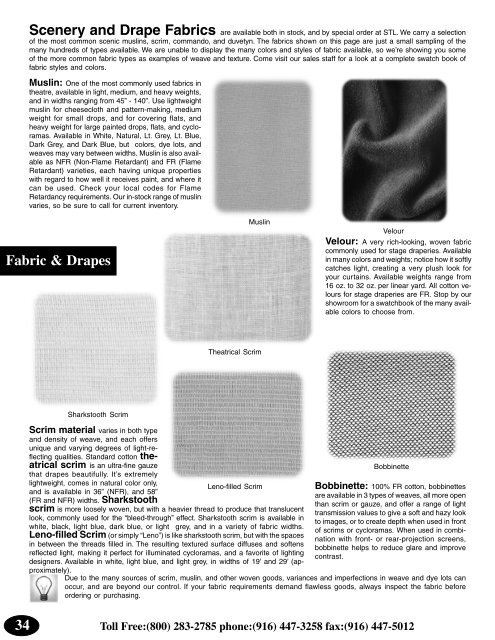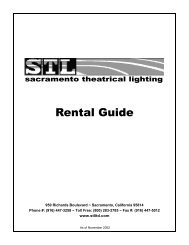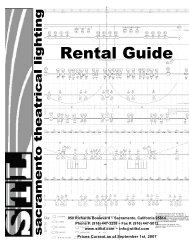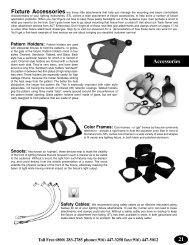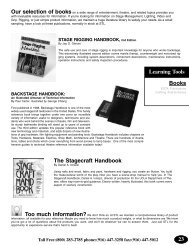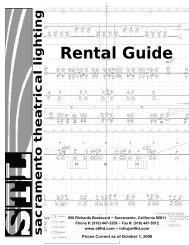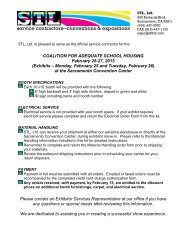Fabric & Drapes - Sacramento Theatrical Lighting
Fabric & Drapes - Sacramento Theatrical Lighting
Fabric & Drapes - Sacramento Theatrical Lighting
Create successful ePaper yourself
Turn your PDF publications into a flip-book with our unique Google optimized e-Paper software.
Scenery and Drape <strong>Fabric</strong>s are available both in stock, and by special order at STL. We carry a selection<br />
of the most common scenic muslins, scrim, commando, and duvetyn. The fabrics shown on this page are just a small sampling of the<br />
many hundreds of types available. We are unable to display the many colors and styles of fabric available, so we’re showing you some<br />
of the more common fabric types as examples of weave and texture. Come visit our sales staff for a look at a complete swatch book of<br />
fabric styles and colors.<br />
Muslin: One of the most commonly used fabrics in<br />
theatre, available in light, medium, and heavy weights,<br />
and in widths ranging from 45” - 140”. Use lightweight<br />
muslin for cheesecloth and pattern-making, medium<br />
weight for small drops, and for covering flats, and<br />
heavy weight for large painted drops, flats, and cycloramas.<br />
Available in White, Natural, Lt. Grey, Lt. Blue,<br />
Dark Grey, and Dark Blue, but colors, dye lots, and<br />
weaves may vary between widths. Muslin is also available<br />
as NFR (Non-Flame Retardant) and FR (Flame<br />
Retardant) varieties, each having unique properties<br />
with regard to how well it receives paint, and where it<br />
can be used. Check your local codes for Flame<br />
Retardancy requirements. Our in-stock range of muslin<br />
varies, so be sure to call for current inventory.<br />
<strong>Fabric</strong> & <strong>Drapes</strong><br />
Dimming Controls<br />
Muslin<br />
<strong>Theatrical</strong> Scrim<br />
Velour<br />
Velour: A very rich-looking, woven fabric<br />
commonly used for stage draperies. Available<br />
in many colors and weights; notice how it softly<br />
catches light, creating a very plush look for<br />
your curtains. Available weights range from<br />
16 oz. to 32 oz. per linear yard. All cotton velours<br />
for stage draperies are FR. Stop by our<br />
showroom for a swatchbook of the many available<br />
colors to choose from.<br />
Sharkstooth Scrim<br />
Scrim material varies in both type<br />
and density of weave, and each offers<br />
unique and varying degrees of light-reflecting<br />
qualities. Standard cotton theatrical<br />
scrim is an ultra-fine gauze<br />
that drapes beautifully. It’s extremely<br />
lightweight, comes in natural color only,<br />
and is available in 36” (NFR), and 58”<br />
(FR and NFR) widths. Sharkstooth<br />
Leno-filled Scrim<br />
scrim is more loosely woven, but with a heavier thread to produce that translucent<br />
look, commonly used for the “bleed-through” effect. Sharkstooth scrim is available in<br />
white, black, light blue, dark blue, or light grey, and in a variety of fabric widths.<br />
Leno-filled Scrim (or simply “Leno”) is like sharkstooth scrim, but with the spaces<br />
in between the threads filled in. The resulting textured surface diffuses and softens<br />
reflected light, making it perfect for illuminated cycloramas, and a favorite of lighting<br />
designers. Available in white, light blue, and light grey, in widths of 19’ and 29’ (approximately).<br />
Bobbinette<br />
Bobbinette: 100% FR cotton, bobbinettes<br />
are available in 3 types of weaves, all more open<br />
than scrim or gauze, and offer a range of light<br />
transmission values to give a soft and hazy look<br />
to images, or to create depth when used in front<br />
of scrims or cycloramas. When used in combination<br />
with front- or rear-projection screens,<br />
bobbinette helps to reduce glare and improve<br />
contrast.<br />
Due to the many sources of scrim, muslin, and other woven goods, variances and imperfections in weave and dye lots can<br />
occur, and are beyond our control. If your fabric requirements demand flawless goods, always inspect the fabric before<br />
ordering or purchasing.<br />
34<br />
Toll Free:(800) 283-2785 phone:(916) 447-3258 fax:(916) 447-5012
Stage Draperies are custom made to your - or our - specification, sized appropriately to fit your specific space or<br />
application. Stage draperies are usually fabricated using cotton velour fabrics because of the rich look and “handling”, but there are other<br />
less expensive fabric options to consider. When requesting a quotation for stage draperies, there are many fabrication and construction<br />
details to consider. It’s very helpful for us to speak in the same terms when it comes to ordering Stage Draperies. Use the diagrams and<br />
terminology provided below to help us provide you with the exact finished goods you require.<br />
Height and Width of the finished curtain: Provide us with the size of your proscenium opening, and we can recommend<br />
an appropriate size for your finished goods; or simply measure your existing curtains if you’re replacing them. When measuring height,<br />
measure to the top of the existing drape, and not to the track or pipe from which the drape is suspended.<br />
Fullness: Fullness is an amount of additional fabric sewn into the finished drape to achieve a plush, full look. Cycloramas and Scrims<br />
are always sewn flat, with no fullness. Most velour stage curtains are sewn with 50% fullness, but a very rich and full look requires 75-<br />
100% fullness. Remember that the weight of the finished drape increases with more fullness.<br />
Top Hem Finish: A standard top finish hem usually begins by sewing the curtain fabric to a 3-1/2” jute webbing (see example B).<br />
For pipe-mounted drapes, grommets with tie lines or cloth tape (examples B, C) are then punched through the webbing, usually every<br />
12”. Track mounted draperies can have either S-hooks (example A) or snaps placed through the grommets, but sewn-in snaps are<br />
frequently used for a nicer finish. These snaps can be sewn so that the top of the snap is 1” above the top hem, or sewn “hidden”,<br />
meaning that the entire snap is concealed, sewn to the back of the top hem, as shown in example D.<br />
Bottom Hem Finish: A number of different methods are used to finish the bottom hem of a stage drapery, depending upon the<br />
type of curtain. For bipart drapes, and other drapes sewn with fullness, an internal canvas pocket containing a weight chain is sewn into<br />
a 6” bottom hem. For flat curtains and cycloramas, a pipe pocket or flap is sewn to the bottom hem. This is essentially a canvas pocket<br />
sized to accommodate the circumference of a steel weight pipe. A standard pipe pocket (example E) requires the pipe to be slid in from<br />
the side. However, space constraints may prohibit this, so a pipe flap may be requested; cloth tape, velcro,<br />
or tie lines secure the weight pipe. A pipe flap allows the pipe to be attached to the bottom hem from the<br />
back of the drape, rather than from the side, thus conserving the space required for the loose pipe. For<br />
curtains that extend down to the stage floor, the pipe pocket or flap is usually sewn behind the bottom hem,<br />
so that the bottom of the pipe pocket is held slightly higher than the bottom of the actual curtain finished<br />
hem. In this manner, the actual bottom hem touches the stage floor, completely masking the activities<br />
behind the curtain (example F).<br />
<strong>Fabric</strong> & <strong>Drapes</strong><br />
Side Hems: Standard side hems can be anywhere from 2-6” for legs, borders, and non-biparting drapes. Biparting drapes are<br />
finished slightly different on the onstage and offstage hems, because the movement of the drapery panel may tend to cause “billowing”<br />
of the drape while closing. To prevent this, the onstage hem of a bipart is usually 12” or more in width. We think a full 24”, or even a halffabric<br />
width is better, because it helps just a little more.<br />
Curtain style: You may desire something a little fancier than the standard bipart drape. Tab, Austrian, and Contour (or Venetian)<br />
style drapes - shown on the next page - offer a very formal look to your stage setting, but also require some very special fabrication<br />
attention. Because of this, we recommend contacting our Special Projects Department for more assistance with any of these styles of<br />
drape fabrication.<br />
Top Hem<br />
Grommets/S-hooks<br />
Hidden Tape Ties<br />
A<br />
B<br />
Top Hem<br />
Grommets/Tie lines<br />
C<br />
Pipe Pocket w/ flap<br />
Top Hem<br />
Hidden Snaps<br />
Pipe Pocket<br />
D<br />
E<br />
F<br />
Toll Free:(800) 283-2785 phone:(916) 447-3258 fax:(916) 447-5012<br />
35
<strong>Drapes</strong> not only add an exquisite look to the stage setting, but also provide functionality by helping to mask, or hide, parts of the<br />
off-stage areas. These areas are commonly used to store props, scenery elements, and also serve as a waiting area for actors prior to<br />
their entrance on stage (“waiting in the wings”). A properly designed stage drapery layout provides full masking of the offstage nonperformance<br />
areas, and also creates a visually pleasing aesthetic enhancement. At STL, we provide and install drapery systems of<br />
many styles, each custom designed to fit the specific application. Call our sales team for more information about how to buy the<br />
appropriate draperies for your performance space.<br />
These styles of Main Drapery layouts have become very common<br />
over the years. The Tab curtain, when closed, appears just the same<br />
as a standard bipart drape. However, the Tab curtain opens by pulling<br />
the bottom onstage corner of each half-panel up (as shown at right).<br />
The Venetian style begins as a single finished drapery panel, sewn with fullness,<br />
but also with several vertical lift wires attached along the width. Opening of the<br />
drape is accomplished by lifting the bottom hem up, using the lift wires, such that<br />
the drapery fabric gathers as the bottom hem rises. A Countour curtain is simply<br />
a Venetian style drape opened in a “contoured” manner (as shown at lower right).<br />
For a more elaborate and elegant look, the Austrian drape is accomplished by<br />
adding vertical fullness to the sewn finished drape. This causes the rich, swagged<br />
look as shown in the diagram below. All of these drapery styles require special<br />
rigging to accomplish the finished look. Using equipment from H & H Specialties,<br />
our Special Projects department can help you design a drapery rigging system<br />
that fits your space.<br />
Tab (Tableau)<br />
Curtain<br />
<strong>Fabric</strong> & <strong>Drapes</strong><br />
Contour<br />
Curtain<br />
Dimming Controls<br />
Austrian Curtain<br />
Main Valance<br />
Border<br />
Main Bipart<br />
Masking Legs<br />
Rear Bipart<br />
Generic Stage Drapery Layout<br />
36<br />
Toll Free:(800) 283-2785 phone:(916) 447-3258 fax:(916) 447-5012


